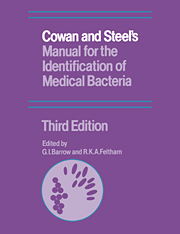Book contents
- Frontmatter
- Contents
- Foreword
- Preface to the first edition
- Postscript
- Preface to the second edition
- Preface to the third edition
- List of contributors
- Introduction
- 1 Classification and nomenclature
- 2 Culture media: constituents and sterilization
- 3 Principles of isolation
- 4 Bacterial characters and characterization
- 5 Theory and practice of bacterial identification
- 6 Characters of Gram-positive bacteria
- 7 Characters of Gram-negative bacteria
- 8 Taxonomy in theory and practice
- 9 Bacterial identification by cards
- 10 Bacterial identification by computer
- 11 Quality control in microbiology
- Appendices
- A Preparation and control of culture media
- B Staining: reagents and methods
- C Characterization tests
- D Test organisms
- E Preparation and use of Identicards
- F Use of computers
- G The Bacteriological Code
- H The Approved Lists of Bacterial Names
- I Reconciliation of Approaches to Bacterial Systematics
- J Glossary
- References
- Index
A - Preparation and control of culture media
Published online by Cambridge University Press: 15 December 2009
- Frontmatter
- Contents
- Foreword
- Preface to the first edition
- Postscript
- Preface to the second edition
- Preface to the third edition
- List of contributors
- Introduction
- 1 Classification and nomenclature
- 2 Culture media: constituents and sterilization
- 3 Principles of isolation
- 4 Bacterial characters and characterization
- 5 Theory and practice of bacterial identification
- 6 Characters of Gram-positive bacteria
- 7 Characters of Gram-negative bacteria
- 8 Taxonomy in theory and practice
- 9 Bacterial identification by cards
- 10 Bacterial identification by computer
- 11 Quality control in microbiology
- Appendices
- A Preparation and control of culture media
- B Staining: reagents and methods
- C Characterization tests
- D Test organisms
- E Preparation and use of Identicards
- F Use of computers
- G The Bacteriological Code
- H The Approved Lists of Bacterial Names
- I Reconciliation of Approaches to Bacterial Systematics
- J Glossary
- References
- Index
Summary
GENERAL CONSIDERATIONS
The ability of some bacteria to grow on media that are inhibitory to other bacteria gives the former organisms additional special characteristics that may help in their identification. The media themselves, with their selective and differential qualities, are of particular interest in diagnostic bacteriology and for this reason we have sometimes included a few notes on the isolation of certain bacteria and have referred occasionally to enrichment and other media used in culturing organisms from clinical material. We emphasize, however, that this Manual is concerned with how to identify organisms that have been isolated and not with how to isolate them.
In this appendix, media are listed under the following section numbers and headings:
A2.1 Basic media
A2.2 Enriched and enrichment media
A2.3 Differential and selective media
A2.4 Media for enhancing pigment production
A2.5 Media for carbohydrate studies
A2.6 Miscellaneous media
Cleaning and sterilization of glassware
Glassware for media such as Koser's citrate, in which there is a single source of an element such as carbon or nitrogen must be chemically clean to be free from it. A recommended method of ensuring this is to boil all tubes in 20% nitric acid for 5–10 minutes and then wash and rinse well with with glass-distilled water. Tubes are dried in an oven in the inverted position in baskets lined with filter or blotting paper to prevent the mouths of the tubes touching the metal.
- Type
- Chapter
- Information
- Publisher: Cambridge University PressPrint publication year: 1993
- 4
- Cited by



